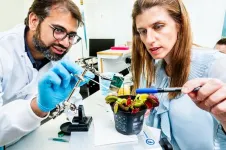(Press-News.org)
A new study by Simon Fraser University researchers shows that efforts to reduce methane emissions are needed immediately if we are to meet global climate change goals.
A key element of the 2015 Paris Agreement, a legally binding international treaty on climate change, is the commitment to limit average global temperatures increases to well below 2°C above pre-industrial levels, and pursue efforts to limit global warming to 1.5°C above pre-industrial levels. This requires reaching net-zero CO2 emissions by or around 2050—and deep reductions in methane and other emissions.
The study, published in Nature’s Communications Earth & Environment, suggests that global warming levels, relative to the pre-industrial period, could be limited below 2°C if global-scale methane mitigation efforts are initiated before 2030.
However, delaying methane mitigation to the year 2040, or beyond, would increase the risk of global warming levels exceeding 2°C above pre-industrial levels, even if net-zero carbon dioxide (CO2) emissions were achieved.
Methane is second only to CO2 in contributing to global temperature increases over the last two centuries. Over the past 40 years, more than 60 per cent of global methane emissions have emerged because of anthropogenic activities such as fossil fuel exploitation, livestock production, agriculture, and waste.
“We emphasize that actions associated with the Global Methane Pledge should not be delayed, because every year of delayed methane mitigation implies further global warming,” says Kirsten Zickfeld, distinguished professor of climate science, director of SFU’s Climate Research Lab, and member of the research team.
“While policymakers now accept the need for urgent methane mitigation, it is necessary to emphasize the importance of immediate mitigation to comply with the temperature goal in the Paris Agreement – particularly taking into account potential Earth system feedbacks,” says Claude-Michel Nzotungicimpaye, former PhD student at SFU, researcher on Zickfeld’s team, and the study’s lead author.
In their study, Zickfeld’s team uses an Earth system model with a coupled methane cycle to examine the importance of immediate versus delayed methane mitigation to fulfil the 2°C threshold. They investigate the role of feedback in carbon and methane cycles in the timing of methane mitigation to achieve the Paris Agreement climate goal, as well as the long-term climate impacts of delaying or failing to mitigate methane in the current century, which has not previously been studied.
As per the group’s findings, every 10-year delay in methane mitigation will result in an additional peak global warming temperature of approximately 0.1°C.
Their results emphasize the need for immediate cuts in anthropogenic methane emissions across the world, along with stringent CO2 mitigation, to increase the likelihood of holding the rise in average global temperatures to well below 2°C above pre-industrial levels.
END
Lizards may miss out on mating opportunities and pick partners more hastily under warming temperatures
###
Article URL: https://journals.plos.org/plosone/article?id=10.1371/journal.pone.0285656
Article Title: Behavioural plasticity in activity and sexual interactions in a social lizard at high environmental temperatures
Author Countries: Argentina
Funding: N.R. - Student Research Grant 2019 - Animal Behavior Society https://www.animalbehaviorsociety.org/web/index.php. M. C. - Consejo Nacional ...
Fungi which normally decay wood can effectively break down low density polyethylene (LDPE) plastic instead - and do so best in the absence of wood
###
Article URL: https://journals.plos.org/plosone/article?id=10.1371/journal.pone.0288133
Article Title: Wood decay fungi show enhanced biodeterioration of low-density polyethylene in the absence of wood in culture media
Author Countries: Sri Lanka
Funding: 1. RNA: TWAS research grant 18-020 RG/BIO/AS_I The world academy of science https://twas.org/ 2. RNA, PW, HH: ICGEB research grant CRP/LKA18-03 https://www.icgeb.org/ International Center for genetic engineering and biotechnology 3. RNA, HH: t(NSF/RG/2019/BT/03). http://www.nsf.ac.lk/ ...
What happens inside the carnivorous plant Venus Flytrap when it catches an insect? New technology has led to discoveries about the electrical signalling that causes the trap to snap shut. Bioelectronic technology enables advanced research into how plants react to their surroundings, and to stress.
Most people know that the nervous system in humans and other animals sends electric impulses. But do plants also have electrical signals even though they lack a nervous system? Yes, plants have electrical signals that are generated in response to touch and stress factors, such as wounds caused by herbivores and attacks on their roots. As opposed to animals, who can move out of the ...
Many gardeners will tell you that aphids are the bane of their existence. According to a new study from the University of Florida, these tiny pests also pose problems for the iconic monarch butterfly. The study found that when oleander aphids infested tropical milkweed — a nonnative milkweed species commonly used across southern portions of the U.S. stretching from California to Florida — the butterflies laid fewer eggs on the plants, and caterpillars developing on those plants were slower to mature.
Monarch butterflies depend on milkweed and its close relatives to complete their life ...
All plants and lichens listed as endangered under the Endangered Species Act are sensitive to climate change but there are few plans in place to address this threat directly, according to a new study by Amy Casandra Wrobleski of Pennsylvania State University and colleagues, published July 26, 2023 in the open-access journal PLOS Climate.
Climate change is expected to have a major impact on species around the world, especially endangered species, which are already rare. A majority of the organisms listed under the Endangered Species Act are ...
More often, people are turning to consumer wearable devices, such as smartwatches, to monitor their health and physical activity.
Using these wearable devices, a study led by Michigan Medicine and the University of Missouri with Saint Luke’s Mid America Heart Institute finds that taking more daily steps is associated improved health, including fewer symptoms and physical limitations, for people with heart failure. The results are published in JACC: Heart Failure.
Clinicians are increasingly presented with their patients’ wearable device data, ...
BENTLEY UNIVERSITY
A new study from Bentley University’s Center for Integration of Science and Industry demonstrates that the National Institutes of Health (NIH) spent $950 million on basic or applied research associated with patents that provided manufacturers with market exclusivity. This amount represents <1% (0.59%) of the $164 billion in total NIH funding for research contributing to the approval of these products.
The article in PLOS ONE titled “NIH funding for patents that contribute ...
People with heart failure who increase their daily step count also saw improvements in their health status over a 12-week period, according to a study published today in JACC: Heart Failure. The study suggests that physical data from wearable devices, such as step count, can be clinically significant and has the potential to inform future clinical trials and clinical care.
Consumer wearable devices to track health status and progress are commonly used and part of a growing trend of mobile health technology. However, how to interpret data from wearable devices, including step count, is at times ...
Who lived at Machu Picchu at its height? A new study, published today in Science Advances, used ancient DNA to find out for the first time where workers buried more than 500 years ago came from within the lost Inca Empire.
Researchers, including Jason Nesbitt, associate professor of archaeology at Tulane University School of Liberal Arts, performed genetic testing on individuals buried at Machu Picchu in order to learn more about the people who lived and worked there.
Machu Picchu is a UNESCO World Heritage Site located in the Cusco ...
Programmed cell death, a fundamental biological process that facilitates the elimination of old, damaged, infected, and non-functional cells, plays a crucial role in maintaining the balance between health and disease in the human body. Research by the team of Dr Alessandro Annibaldi from the Center for Molecular Medicine Cologne (CMMC) at the University of Cologne has uncovered a novel mechanism of cell death regulation, shedding light on its significance during conditions such as SARS-CoV infection and skin injury. The study ‘Cleavage ...



